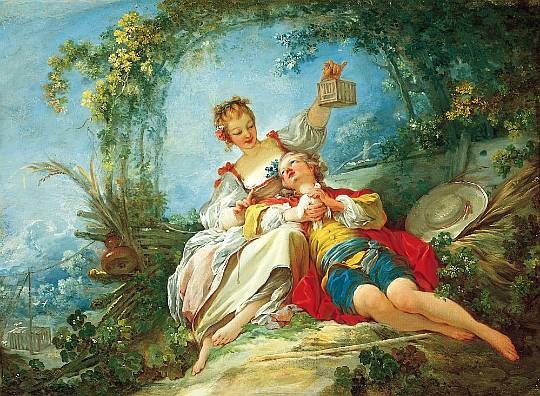Charpentier, Rameau sparkle in French Valentine from Boston Baroque
What would a Valentine’s Day concert of French music be without a touch of double entendre?
Addressing the audience Friday night in New England Conservatory’s Jordan Hall, Boston Baroque music director Martin Pearlman attempted to summarize the vaporous plot of Jean-Philippe Rameau’s pastoral opera-ballet La Guirlande (The Garland).
When he got to the part where the shepherd Myrtil, having been unfaithful to the shepherdess Zélide, experienced remorse and “his garland wilted,” a slow-building crescendo of laughter swept the august chamber.
Unfazed, Pearlman synopsized on to the end, then turned and led a spirited concert rendering of La Guirlande that had quite a few intentional laughs in it, thanks to charming performances by soprano Amanda Forsythe and haute-contre (high tenor) Lawrence Wilford as the (briefly) indignant shepherdess and her (temporarily) guilt-ridden swain.
In other remarks, Pearlman characterized the concert—which also included a Te Deum by Marc-Antoine Charpentier and a garland of orchestral numbers from Rameau’s other operas—as a rescue mission for the colorful music of the French Baroque, whose esoteric issues of ornamentation and performance practice have tended to make it a stranger to audiences and performers alike.
What wasn’t to like about Charpentier’s robust piece for chorus, soloists, and an orchestra ablaze with trumpets and drums? The composer, whose career and subsequent reputation were stunted by the intrigues of Louis XIV’s court composer Jean-Baptiste Lully, was most admired for his sensitivity, but in this case he responded to a French military victory with music of a sweep and splendor to rival a much later Baroque master, Handel. (In fact, the TV network Eurovision adopted this work’s grand opening movement as its theme music.)
On Friday night, trumpeters Jesse Levine, Robinson Pyle, and Paul Perfetti skillfully coaxed shapely phrases and trills from their valveless instruments, while Jonathan Hess brought both power and finesse to his timpani.
If one couldn’t hear much else when those four were playing, there were plenty of opportunities elsewhere to savor the mellow Baroque strings, flutes, oboes, vocal ensembles, and chorus, as Charpentier set each phrase of the celebratory text as a striking character piece with a sonority of its own.
The chorus was clear-toned and expressive in music that tended more to the homophonic “wall of sound” than to fugal polyphony. Individual chorus members also did fine work in trios and quartets.
Guest vocalists Forsythe, Wilford and baritone Andrew Garland took solo turns—Wilford and Garland sturdy without becoming stentorian, and Forsythe memorable in dialogue with Christopher Krueger’s and Wendy Rolfe’s ethereal Baroque flutes—and tried to blend their big voices in ensembles with their choral colleagues, Forsythe sometimes not quite succeeding.
As he would do all evening, Pearlman led the well-paced performances with taut, economical, yet expressive gestures.
Charpentier’s colorful music somewhat undermined Pearlman’s spoken claim that Rameau, born 40 years later than Charpentier, was “history’s first great orchestrator”—that is, the first composer to treat the orchestra as a palette of tone colors with which to create ever-changing sounds and effects.
Still, it was not for nothing that Debussy, after hearing a performance of La Guirlande in 1903, reportedly said, “Long live Rameau—down with Gluck!” On Friday night the sonorities that captivated the Impressionist master were on display not only in the opera but in the gathering of orchestral pieces that preceded it.
Actually, Rameau’s Overture to Zaïs repeatedly evoked thoughts of later composers—late Beethoven in the halting, disjointed phrases that represented Chaos as the piece began, Prokofiev in the subsequent merry bustle and sudden ending.
Pairs of minuets from Platée and Zoroastre offered a pleasing contrast, one mellow and amber-toned in musette (bagpipe) style, the other floating a graceful piccolo solo over a lilting one-to-a-bar beat.
The closing Chaconne of Les Indes galantes was, in its way, as vivid and diverse a set of variations on a ground bass as the one that closed Brahms’s Fourth Symphony a century and a half later.
After displaying its Rameauean wares so convincingly, the orchestra accepted a subsidiary but still colorful role as the audience’s attention turned to more important matters, such as the fate of two flower garlands whose condition served as a barometer of their owners’ faithfulness.
As the lovers, Forsythe and Wilford navigated their fanciful situation with the right balance of sincerity and sendup. Her pretty and piercing voice occasionally flared out as if it would be more at home in Fenway Park than Jordan Hall, but in the main she gave an attractive and characterful performance, touched here and there with sparkling coloratura.
Wilford also sang unnecessarily loud at times, but was smooth, even and articulate throughout his range, and gave a good account of the haute-contre style, the high male voice that French audiences of the time preferred to the stratospheric countertenor or castrato.
The two singers managed to blend their somewhat different timbres in the duets, and deftly exchanged lightning-fast roulades in the virtuoso arias “Triomphe, triomphe, Amour” and “Vole, Amour.”
A third Garland—baritone Andrew—briefly contributed in the role of the suitor Hylas, whose sole function here, hélas, was to be sent away by the faithful Zélide.
The chorus of shepherds and shepherdesses sang with character as well, solemnly invoking the god Amour (Cupid) one moment and zestfully anticipating amorous pleasures the next.
The interspersed dances were not as abundant as one might expect in a work its composer called an “acte de ballet,” but what there was was choice: a melodious minuet with oboes, a rich-toned musette featuring the bassoon, a lively gavotte, and a rousing, tambourine-driven contredanse to wrap up the evening.
The program will be repeated 3 p.m. Sunday. bostonbaroque.org; 617-987-8600.
Posted in Performances

Posted Feb 17, 2014 at 8:30 am by Carl Goodman
Sunday’s performance was wonderful. And it was a treat – no a gift – to again hear Amanda Forsythe. She was superior. And her stage presence compliments her beautiful voice.